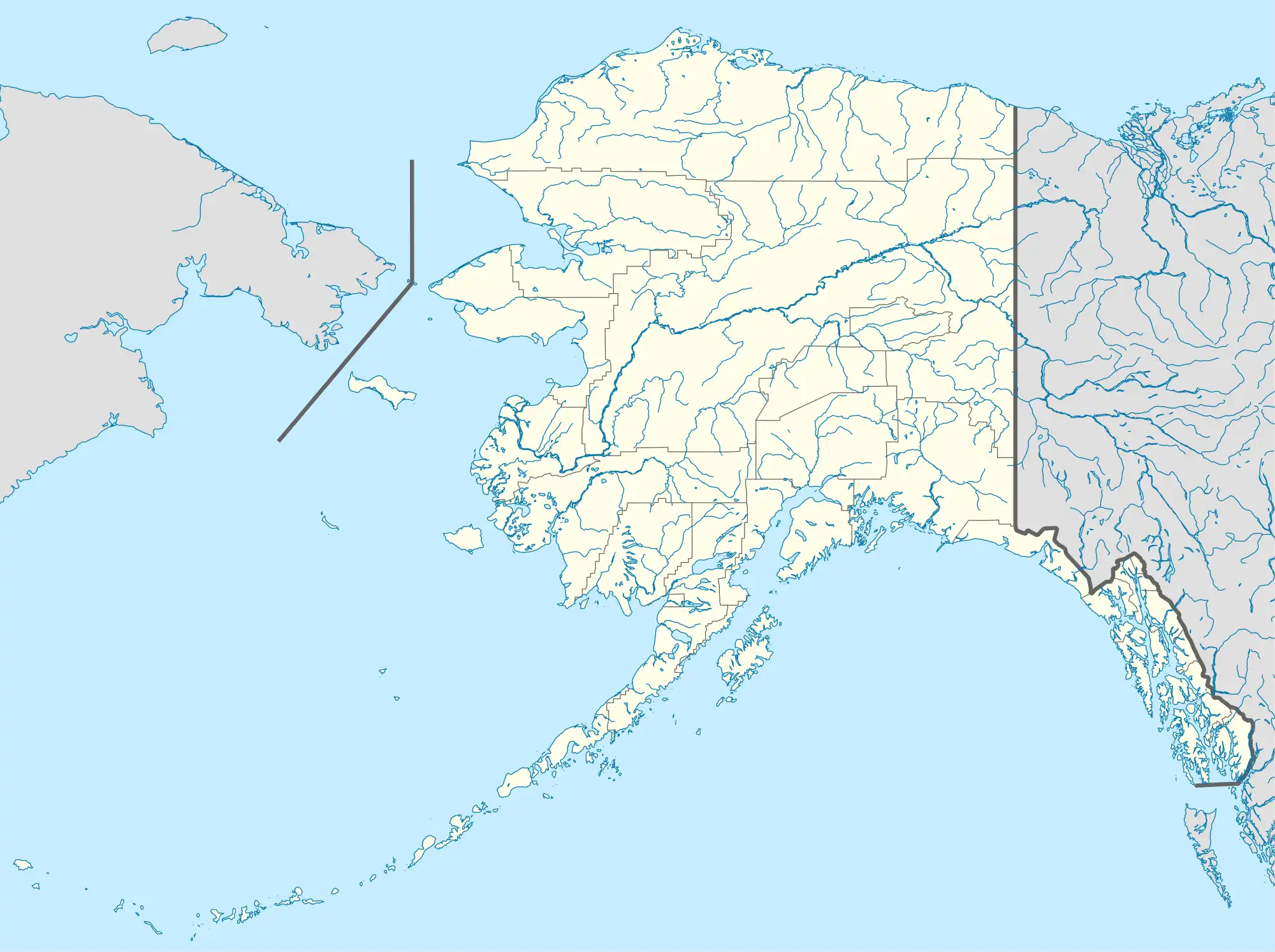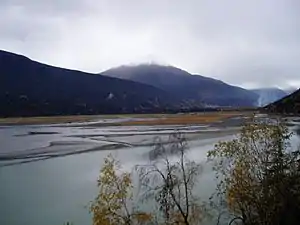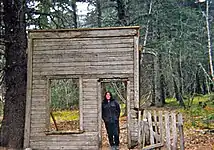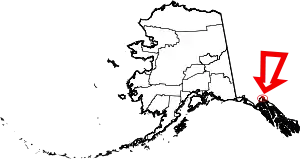Dyea, Alaska
Dyea (/daɪˈiː/ dye-EE) is a former town in the U.S. state of Alaska. A few people live on individual small homesteads in the valley; however, it is largely abandoned. It is located at the convergence of the Taiya River and Taiya Inlet on the south side of the Chilkoot Pass within the limits of the Municipality of Skagway Borough, Alaska. During the Klondike Gold Rush prospectors disembarked at its port and used the Chilkoot Trail, a Tlingit trade route over the Coast Mountains, to begin their journey to the gold fields around Dawson City, Yukon, about 800 km (500 mi) away. Confidence man and crime boss Soapy Smith, famous for his underworld control of the town of Skagway in 1897–98 may have had control of Dyea as well.[1]
Dyea | |
|---|---|
_1.jpg.webp) The Dyea waterfront during the Klondike Gold Rush. | |
 Dyea Location within the state of Alaska | |
| Coordinates: 59°30′16″N 135°21′36″W | |
| Country | United States |
| State | Alaska |
The port at Dyea had shallow water, while neighboring Skagway had deep water. Dyea was abandoned when the White Pass and Yukon Route railroad chose the White Pass Trail (instead of the alternative Chilkoot Trail), which began at Skagway, for its route.
Use of the name Dyea for its present location first occurred in 1886, when John J. Healy (1840-1908) and Edgar Wilson (1842-1895) opened their trading post there. Prior to that year, only a small hunting and fishing cabin had existed at the location.[2] Prior to 1886, Dyea or Dei-yi [phonetic spelling] had been the second half of the name Jilḵoot Dei-yi [Chilkoot-owned Trail].[3] Prior publications state that Dyea was derived from the words for “to pack” [yaa] or “carrying place” [yaa yé].[4] However, the presence of the initial \d\ sound in Dyea casts doubt on those latter possibilities, and suggests that the first syllable was in fact dei (as in dei-yi).
Chilkoot Trail and Dyea Site is a U.S. National Historic Landmark.
Dyea is now within the Klondike Gold Rush National Historical Park. All that remains are a number of foundations surrounded by scraps of lumber and metal, 3 cemeteries, including one where almost every person buried died on the same date in 1898 in an avalanche on the gold rush trail,[5] and the ruins of the wharf.[6] Visitors can usually spot brown bears, black bears, and eagles. Brown bears tend to use the Dyea inlets to feed during salmon spawning season (July–August).


.jpg.webp)
Demographics
| Census | Pop. | Note | %± |
|---|---|---|---|
| 1900 | 261 | — | |
| U.S. Decennial Census[7] | |||
Dyea appeared one time on the U.S. Census in 1900 as an unincorporated village. It has since been annexed into the city of Skagway.
References
- Smith, Jeff (2009). Alias Soapy Smith: The Life and Death of a Scoundrel. Klondike Research. pp. 450–51. ISBN 978-0-9819743-0-9.
- “May 1886 I established a trading-post at a place now called Dyea, … with Edgar Wilson, … who resided at Dyea up to … his death in 1895.” Healy Dep., May 20, 1903, Proceedings of the Alaska Boundary Tribunal, S. Doc. No. 162, 58th Cong. (2nd Sess. 1903), Vol. IV, App. 2, at page 233, reprinted in, Serial 4602. Prior to 1886, only a small hunting and fishing cabin had existed at this location. Krause, Aurel; Krause, Arthur (1993). To the Chukchi Peninsula and to the Tlingit Indians 1881/1882. University of Alaska Press. ISBN 978-0-912006-66-6., at page 202 (map entry: “Kleines Jagd & Fischerhaus” [German]).
- “The trail … is known among the Indians as the Chilkoot trail … It was monopolized solely by the Chilkoots, who had even gone so far as to forbid the Chilkats, almost brothers in blood, from using it …” Schwatka, Frederick G. (1893). A Summer in Alaska. J. W. Henry., at page 60. It is, however, unlikely that the Indians used the English word for trail! Because the Chilkoot Indians claimed ownership of the trail, it would have been called Chilkoot Dei-yi [Chilkoot-owned Trail]. Edwards (2009). Dictionary of Tlingit (PDF). pp. 70, 476 (dei [trail]), 16 (When possessed, alienable nouns require the possession suffix -[y]i). Retrieved September 14, 2015.
- Thornton, Thomas F., ed. (2012). Haa Léelk'w Hás Aaní Saax'ú:Our Grandparents' Names on the Land (PDF). Sealaska Heritage Institute. p. 57 (#28: To pack). ISBN 978-0-295-98858-0. Retrieved October 16, 2017.; Phillips, James W. (1973). Alaska-Yukon Place Names. University of Washington Press. ISBN 0-295-95259-8., at page 43 (Dyea “Tlingit word purportedly meaning “carrying place”).
- "The Slide Cemetery". Atlas Obscura. Retrieved May 10, 2023.
- nps.gov
- "U.S. Decennial Census". Census.gov. Retrieved June 6, 2013.
External links
- Guide to Dyea, Alaska from ExploreNorth
- Dyea page at Klondike Gold Rush National Historic Park
- Historic American Engineering Record (HAER) No. AK-38, "Dyea Townsite (Ruins), Skagway, Municipality of Skagway Borough, AK", 8 photos, 1 color transparency, 1 photo caption page
